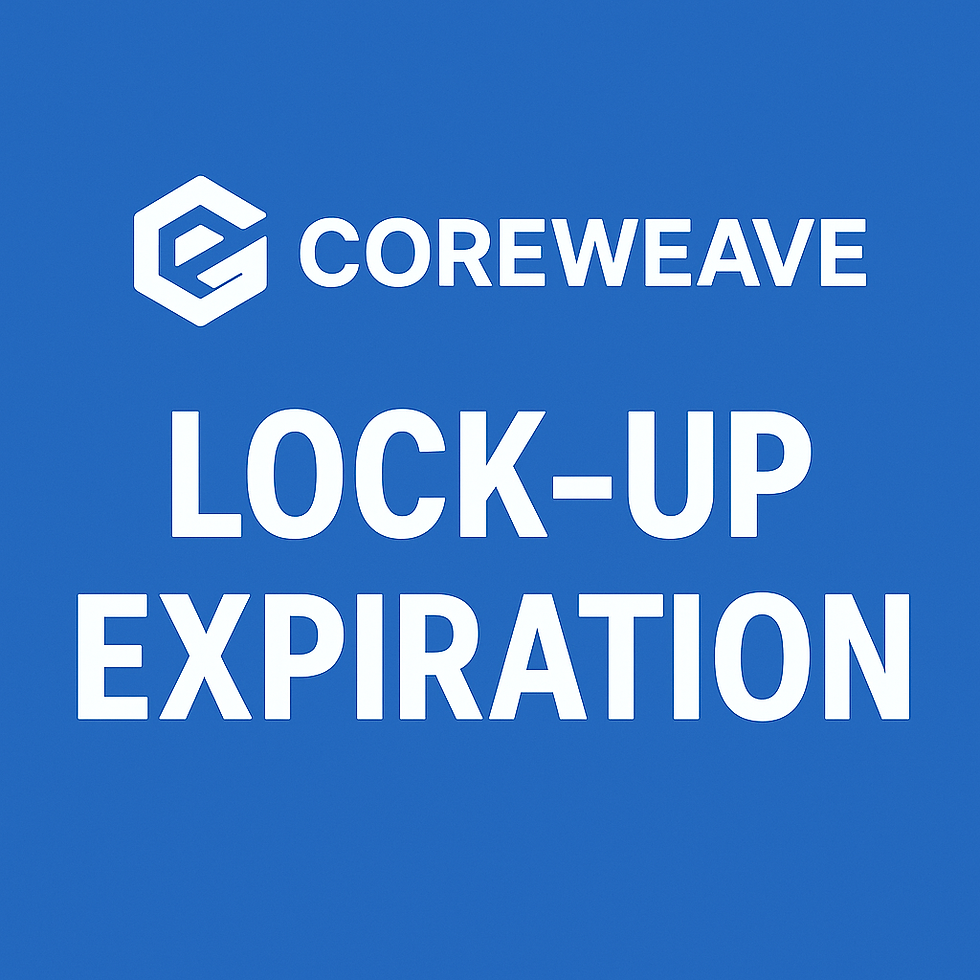CoreWeave’s Lock-Up Expiry: What Investors Need to Know About Market Impact, Past Trends, and the Big Players
- BC

- Aug 11
- 3 min read
As CoreWeave (NASDAQ: CRWV) approaches its August 15th lock-up expiration (A lock-up expiration is the date when insiders — such as company executives, employees, and early investors — are finally allowed to sell their shares after an IPO or private funding round.), the AI infrastructure firm is at a critical juncture that could introduce significant stock market volatility. This event will unlock an estimated 83% of the company's Class A shares, allowing insiders and early investors to sell their holdings for the first time since the company's IPO on March 28,

2025. This report provides an expanded analysis of what this could mean for investors, a broader look at how other major tech companies have performed under similar circumstances, and a detailed breakdown of CoreWeave's ownership structure.
Who Owns CoreWeave and Who Can Sell?
A significant portion of CoreWeave's shares are held by its founders, venture capital firms, and other key initial backers. The expiration of the lock-up agreement will allow these stakeholders to liquidate their positions, which could lead to a substantial increase in the number of shares available for trading.
Based on public filings, here are some of the key shareholders who will be eligible to sell their stock:
Founders and Executives: CoreWeave's co-founders, including CEO Michael Intrator, CTO Brian Venturo, and Chief Strategy Officer Brannin McBee, hold a significant portion of the company's voting power through a dual-class share structure. Their individual holdings represent a substantial portion of the company's ownership.
Venture Capital and Private Equity Firms: A number of prominent investment firms backed CoreWeave before its IPO. These include Magnetar Capital and Coatue Management, among others who will be able to capitalize on their early investments.
Corporate Investors: Notably, NVIDIA Corp. holds a significant stake in CoreWeave, a reflection of the deep strategic partnership between the two companies.
Other Institutional Investors: A wide range of other institutional investors, including hedge funds and asset management firms, also have positions in CoreWeave and will be free to trade their shares after the lock-up expiration.
The decision of these major shareholders to sell or hold their stock will be a key indicator of their confidence in CoreWeave's future. A large-scale sell-off could signal a lack of faith in the company's long-term prospects, while a more measured approach could help to stabilize the stock price.
Expanded Look at Historical Precedents
To offer a more comprehensive perspective, the following table includes additional major tech IPOs and their performance around their lock-up expirations, now with specific percentage changes for the month following the event.
Company | Lock-Up Expiration Date | Performance on Expiration Day | Performance in the Following Month |
Meta (formerly Facebook) | August 16, 2012 | -6.27% | -12.8% |
Uber | November 6, 2019 | -3.80% | +7.2% |
Lyft | August 19, 2019 | -1.50% | -26.4% |
Snap | July 29, 2017 | -1.20% | -11.6% |
Palantir Technologies | February 18, 2021 | -6.09% | -10.5% |
Snowflake | March 5, 2021 (final phase) | -3.53% | -7.9% |
Airbnb | June 9, 2021 | -0.44% | +2.1% |
Analysis of Broader Trends:
This expanded data reinforces the trend of immediate, single-day price declines on the lock-up expiration day. The subsequent month, however, shows a more mixed but generally negative picture.
Clear Downtrends: Most companies, including Meta, Lyft, Snap, Palantir, and Snowflake, saw their stock prices continue to fall, losing between 7.9% and 26.4% in the 30 days following the expiration. This reflects sustained selling pressure as insiders gradually offloaded their shares.
Notable Exceptions: Uber and Airbnb bucked the trend. Uber's stock recovered and gained over 7% in the following month, while Airbnb saw a modest 2% gain. These cases suggest that strong underlying business fundamentals, positive market sentiment, or a belief among insiders in long-term value can overcome the technical selling pressure.
For CoreWeave investors, these historical examples highlight the real possibility of a short-to-medium-term price decline. The combination of a highly concentrated ownership structure and a stock that has performed exceptionally well since its IPO creates a situation where the potential for a significant market reaction is high. Investors should be prepared for a period of heightened volatility. The actions of the company's founders and major institutional backers in the coming weeks will be critical in shaping the narrative and determining the future trajectory of CoreWeave's stock.


Comments